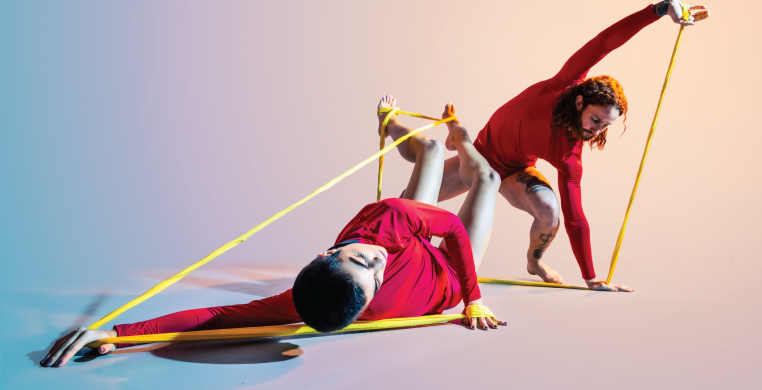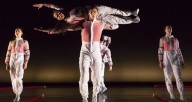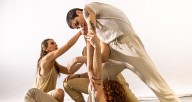37-years loyal to the city of Chicago, Hedwig Dances is known for its eclectic, theatrical flare paired with a love for free-flowing movement. On Friday, April 8th—for their first in-person performance in two, long years—the company stepped boldly into two completely different worlds with a double bill: “Field Theory.”
The filled-to-brim audience digested Rigoberto Saura’s “Raw Concrete,” first. Neutrally colored costumes—think shades of muddy orange, taupe, and tan—set a decidedly blank slate. The white Marley floor, matched by a white curtain hung across the back of the stage, enlarged the raw, exposed performance space. Smoke machines, an ambient score, and obscenely bright, jarring lights intermittently flipped between sensory assault and sensory deprivation. At times I couldn’t keep my eyes open, shying away from the light, and at others, I squinted to try and keep the dancers in focus buried beneath the haze.
The four featured company dancers—Pollux, Holly Lehnertz, Hannah Marcus, and Hanna Swartz—showed undeniable athleticism throughout the run of the 30-something minute piece. In the midst of constant movement, each dancer found their individual stride. Lehnertz audibly used her breath to initiate lengthened moments of contraction and release, while Swartz used the control of their captivatingly long limbs to pull focus towards each intentional contortion of their body. Pollux looked unaffected by the rigor of the piece, keeping their face stoic—unyielding in his pensive concentration. Yet it was Marcus who pulled focus in the most positive of contexts. Her sure-footed confidence and vulnerable expressions made her an integral part of the piece, driving the group forward toward a much-welcomed exhale at the end of the demanding, alluring work.
After a brief 15-minute intermission, Jan Bartoszek—Hedwig Dances founder and artistic director—took us down a rabbit hole filled with basic shapes and primary colors. “LightPlay,” an ode to the Bauhaus movement, was a dance-adjacent performance art piece. The seven-person company of intellectually-motivated movers and shakers—Pollux, Lehnertz, Marcus, and Swartz, with the addition of Richard Echevarria, Jessie Gutierrez, and “Raw Concrete” choreographer Suara—tackled everything from moving through projections to dancing with a projector.
Bartoszek’s “Light Play” included everything and the kitchen sink. Primary-colored hula hoops, giant poles, frisbees, and elongated silks ornamenting the stage were maneuvered about the space in thoughtful patterns by the dancers, dressed in black from head to toe. A bird’s-eye-view projection pulled focus away from the bodies in the space. Circles, triangles, and squares crafted by bodies and props with care were satisfying to witness on the screen from an overhead perspective, yet it was entirely disorienting to watch head-on. I wasn’t sure where my attention should be directed.
Large metal and fabric props carried onto the stage by company dancers helped distract during a transition as all color was removed from the space. In stark contrast to what was happening mere moments before, dancer Pollux—obviously the one portraying Bauhaus—stripped into their underwear and became the backdrop for the black-and-white projections.
After yet another abrupt but well-constructed transition, the white curtain squaring off the stage disappeared to reveal a deep, triangular back portion of the theater. Yet again, the company members moved props across the space, this time it was an overhead projector that flashed me back to doing addition on transparent slides in elementary school. Colored gels and shadowed objects offered Pollux numerous elements to play with, making effective use of the added depth in the space. At times I was worried about dancers pulling the projector by its overly extended chord, but before I had the appropriate amount of time to digest the situation, the lights faded to black signaling the piece was over.
If it weren’t for the overlap of dancers, I would’ve assumed I was watching a split bill rather than a double bill. Saura’s “Raw Concrete” showcased complex and demanding floorwork, swoon-worthy intimate moments, and gravity-defying partner work. In comparison, Bartoszek’s “Light Play” was a theatrical and over-the-top exploration of shape, color, and light—entirely unlike anything I’ve seen before, despite, at times, being visually overwhelming. The juxtaposition between the works undeniably showcases the versatility of Hedwig Dances, all in all, making for a thought-provoking evening of dance and performance art.



